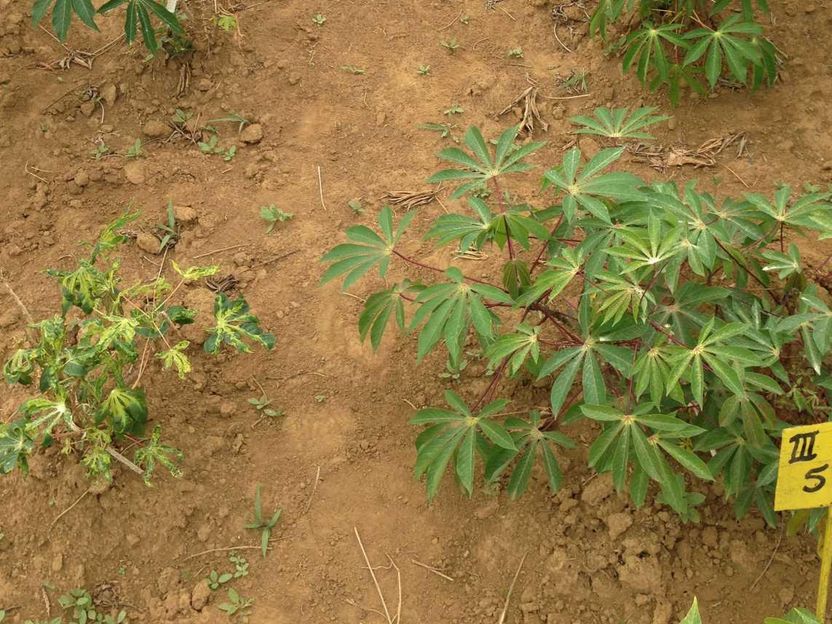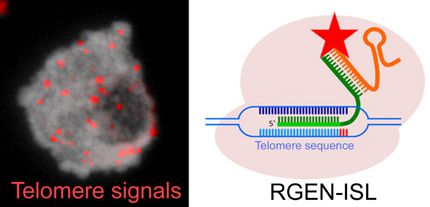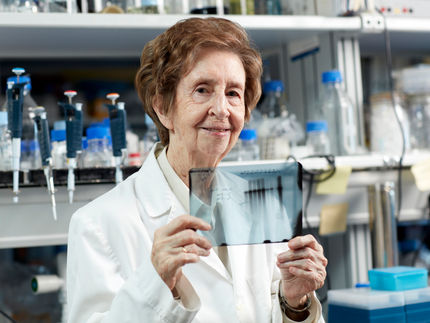Resistance to mosaic disease explained
Researchers from ETH Zurich, the United States and Uganda have identified the gene responsible for resistance in certain cassava cultivars against the devastating cassava mosaic disease. This is an important step for breeding virus-resistant cassava varieties.

The plant on the left is infected by DNA geneminiviruses that cause cassava mosaic disease, while the plant on the right is healthy.
Wilhelm Gruissem / ETH Zürich
Cassava, also known as manioc, is a staple food for nearly one billion people and an important source of raw materials. It secures an income for smallholder farmers, especially in Africa. Cassava is an undemanding crop; it does not need fertiliser and grows even in dry areas.
However, cassava cultivation is impacted by many pests and diseases. Cassava mosaic disease (CMD) in particular is often damaging the crop. CMD is caused by DNA geminiviruses that are transmitted to plants by sap-sucking whiteflies (Bemisia tabaci) and can destroy entire fields and decimate yields.
Cassava mosaic disease is a particularly severe problem in Africa and India. However, the virus is now also spreading through cassava fields in Southeast Asia. Growers and farmers are in urgent need of CMD-resistant cassava cultivars.
Research consortium tracks down resistance gene
Help may be on the way thanks to a discovery by an international research team led by Wilhelm Gruissem, Professor of Plant Biotechnology at ETH Zurich. Working with several resistant and susceptible West African cassava cultivars, the team used elaborate and time-consuming genome analyses to identify the gene responsible for a specific resistance to cassava mosaic virus.
The resistance was originally found by farmers in West Africa, who observed that while the majority of their cassava plants in the field had died as a result of the viral infection, a few plants survived. This attracted the attention of researchers, who then tried to identify the cause of this resistance.
In their study the team led by Wilhelm Gruissem shows that the resistance is caused by a single gene that is the blueprint for a DNA polymerase – an enzyme responsible for replicating DNA within a cell. However, the DNA polymerase not only replicates DNA, it also performs “proofreading” to correct errors in the sequence of DNA building blocks that may occur during replication. And it is precisely this enzyme that the geminiviruses require to replicate their own DNA and consequently to reproduce.
Is the DNA polymerase no working correctly?
Since cassava has a double set of chromosomes, the plant has two copies of each gene. If one copy of the DNA polymerase gene is mutated, the viruses cannot multiply and the infection stops. In plants that are susceptible to the disease, however, both copies of the DNA polymerase gene do not have the mutation that gives rise to the CMD resistance.
“We don’t know yet exactly how the resistance mechanism works,” Gruissem says. “This is something that will need to be investigated in future studies.” But he suspects that the mutations affect an area of the enzyme responsible for error correction during DNA replication. These changes could affect the way the DNA polymerase works, causing it to fail correcting errors in the replicating viral DNA; these errors ultimately stop the virus from replicating and spreading in the plant.
Targeted virus resistant breeding with genome editing
By pinning down the gene responsible for what is known as CMD2 resistance, the researchers are playing an important part in enhancing food security in tropical and subtropical regions. The gene they have identified now serves as a genetic marker for breeders, indicating whether or not the resistance is present in their plants.
For economic and agronomic reasons, exporting stems from virus-resistant cassava plants from West Africa to Asia for field propagation is not feasible. That means Asian breeders have to find another way to introduce the resistance into their plants. “One possibility is to use a modern CRISPR-Cas technology to precisely edit the DNA polymerase gene and activate the disease resistance,” Gruissem says.
This project marks the end of Gruissem’s research activities at ETH Zurich; the 70-year-old is retiring at the end of July. For the next three years, he will continue his research in Taiwan, where he has been awarded a prestigious fellowship. However, he will not be able to continue working on the CMD virus there, as it is not present in Taiwan and importing it for laboratory studies is not permitted. He therefore hopes that his US colleagues will be able to answer the open questions.
The research project involved researchers from ETH Zurich as well as from the Donald Danforth Plant Science Center in St. Louis, the University of California Los Angeles and the National Crops Resources Research Institute in Uganda. A substantial portion of the research funding was provided by the Bill & Melinda Gates Foundation.
























































